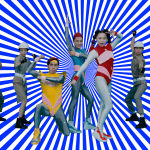Open a larger version of the following image in a popup:
 Su Hui-Yu, The Space Warriors and the Digigrave, 2023-2025
Su Hui-Yu, The Space Warriors and the Digigrave, 2023-2025
 Su Hui-Yu, The Space Warriors and the Digigrave, 2023-2025
Su Hui-Yu, The Space Warriors and the Digigrave, 2023-2025
Open a larger version of the following image in a popup:
 Su Hui-Yu, The Space Warriors and the Digigrave, 2023-2025
Su Hui-Yu, The Space Warriors and the Digigrave, 2023-2025
 Su Hui-Yu, The Space Warriors and the Digigrave, 2023-2025
Su Hui-Yu, The Space Warriors and the Digigrave, 2023-2025
Open a larger version of the following image in a popup:
 Su Hui-Yu, The Space Warriors and the Digigrave, 2023-2025
Su Hui-Yu, The Space Warriors and the Digigrave, 2023-2025
 Su Hui-Yu, The Space Warriors and the Digigrave, 2023-2025
Su Hui-Yu, The Space Warriors and the Digigrave, 2023-2025
Open a larger version of the following image in a popup:
 Su Hui-Yu, The Space Warriors and the Digigrave, 2023-2025
Su Hui-Yu, The Space Warriors and the Digigrave, 2023-2025
 Su Hui-Yu, The Space Warriors and the Digigrave, 2023-2025
Su Hui-Yu, The Space Warriors and the Digigrave, 2023-2025
Open a larger version of the following image in a popup:
 Su Hui-Yu, The Space Warriors and the Digigrave, 2023-2025
Su Hui-Yu, The Space Warriors and the Digigrave, 2023-2025
 Su Hui-Yu, The Space Warriors and the Digigrave, 2023-2025
Su Hui-Yu, The Space Warriors and the Digigrave, 2023-2025
Su Hui-Yu
The Space Warriors and the Digigrave, 2023-2025
Two single channel videos
20 minutes & 8 minutes
Edition 1/6 + 2 AP
Copyright The Artist
Further images
From 1984 to 1987, one of the only three government TV channels in Taiwan, CTS, broadcasted “Space Warriors”, an outlandish sci-fi superhero series adapted from the Japanese series “Super Sentai”...
From 1984 to 1987, one of the only three government TV channels in Taiwan, CTS, broadcasted “Space Warriors”, an outlandish sci-fi superhero series adapted from the Japanese series “Super Sentai” and “Gavan”. After a three-year run, CTS stopped broadcasting the series due to low ratings, unstable production quality, and bad reviews, as well as the rise of VHS and cable TV, which allowed for the original Japanese shows to be watched in Taiwan. “Space Warriors” was a tonkatsu, a Japanese genre that features live action wacky characters and colourful special effects, aimed mostly at children and teenage audiences. The series combined fantasy and folk tales with a nationalist undercurrent, with hints of Confucianism and chauvinism during the last years of Martial law in Taiwan.
Thework is comprised of two different video versions. On the one hand there is the more cinematic and discursive version, where we see a troop of alien characters who want to invade Earth and liberate humans from their capitalistic conception of linear time and the oppressive systems of labour, discipline, and warmongering for a libidinal way of being that prioritises queer sexual desire above all. The aliens, who belong to the “Makelove” species, travel the universe on the Digigrave, a spaceship that is shaped according to an AI reinterpretation of the Chiang Kai-shek Memorial Hall, a monument containing the tomb of the former dictator of Taiwan located in Taipei. These aliens, considered immoral and vicious, are fought by the Space Warriors, a group of human superheroes that seek to maintain the status quo of a labour-centred Earth. They ultimately defeat the aliens, saving the planet from a queer takeover and declaring “Work to die!”.
The other version is an immersive and experimental video that combines elements from the cinematic version with historical characters, AI-generated images, digital effects, and written language. The use of open-source Al tools like motion tracking, facial recognition and image generation reflect on contemporary biopolitical issues, whilst the inclusion of traditional film skills like film shooting, human performances and CG animation represent the classical logics of moving images. With this amalgam, Su seeks to speculate on the idea of reconciliation out of deep scars and current geopolitical quandaries around the nation-state, cultural identity, gender expression, moral, and political ideology.
Thework is comprised of two different video versions. On the one hand there is the more cinematic and discursive version, where we see a troop of alien characters who want to invade Earth and liberate humans from their capitalistic conception of linear time and the oppressive systems of labour, discipline, and warmongering for a libidinal way of being that prioritises queer sexual desire above all. The aliens, who belong to the “Makelove” species, travel the universe on the Digigrave, a spaceship that is shaped according to an AI reinterpretation of the Chiang Kai-shek Memorial Hall, a monument containing the tomb of the former dictator of Taiwan located in Taipei. These aliens, considered immoral and vicious, are fought by the Space Warriors, a group of human superheroes that seek to maintain the status quo of a labour-centred Earth. They ultimately defeat the aliens, saving the planet from a queer takeover and declaring “Work to die!”.
The other version is an immersive and experimental video that combines elements from the cinematic version with historical characters, AI-generated images, digital effects, and written language. The use of open-source Al tools like motion tracking, facial recognition and image generation reflect on contemporary biopolitical issues, whilst the inclusion of traditional film skills like film shooting, human performances and CG animation represent the classical logics of moving images. With this amalgam, Su seeks to speculate on the idea of reconciliation out of deep scars and current geopolitical quandaries around the nation-state, cultural identity, gender expression, moral, and political ideology.





